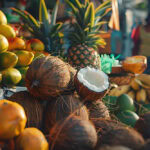Allspice, known scientifically as Pimenta dioica and locally in Costa Rica as pimienta gorda, is a unique spice that plays a defining role in Caribbean cuisine. Despite its name, allspice is not a blend of several spices but a single dried berry that naturally evokes the combined aromas of cinnamon, nutmeg, and cloves. This distinctive profile has made it a cornerstone ingredient in numerous traditional dishes, particularly throughout the Caribbean coast of Central America. Its versatility, depth of flavor, and cultural significance make it a subject of fascination for chefs, food historians, and researchers alike.
Botanical characteristics and origin
Allspice trees are evergreen, thriving in warm, humid climates with well‑drained soils. Native to the Greater Antilles and southern Mexico, the trees were introduced to various regions of Central America centuries ago. They can reach heights of over ten meters, producing dense foliage and clusters of green berries that turn brown as they mature. The spice is harvested when the berries are still green and unripe, then dried in the sun until they develop their characteristic brown color and intense aroma.
The cultivation process requires patience and attention. Farmers often monitor the trees carefully, choosing the optimal time to pick the berries to preserve their essential oils. Once dried, the berries are either used whole or ground into a fine powder, depending on the intended culinary application.
Historical use in Caribbean cultures
Allspice has a long history in the Caribbean, where it became a valued trade commodity. Indigenous communities used the berries not only for seasoning food but also for medicinal purposes and preservation. The spice’s antimicrobial properties helped extend the shelf life of meats and stews in hot climates, a practical advantage long before modern refrigeration.
When European colonizers arrived, they quickly recognized allspice’s potential. Traders carried it across oceans, and it became an integral part of spice blends in kitchens from London to Lisbon. In Caribbean communities like Puerto Limón, allspice maintained a special status, woven into family recipes that combined African, Indigenous, and European influences.
Flavor profile and culinary versatility
The flavor of allspice is at once warm, sweet, and slightly peppery. Its complex profile allows it to stand alone in simple preparations or complement other spices in intricate blends. In Caribbean kitchens, it often appears in marinades for meats, seasoning for rice dishes, and spice rubs for grilled fish. It also finds its way into desserts, lending depth to cakes, puddings, and sweet plantain preparations.
Allspice is especially valued for its ability to balance strong flavors. Scotch bonnet peppers, with their intense heat, are tempered by allspice’s sweetness in jerk marinades. The spice also brings harmony to coconut-based stews, enhancing the richness without overwhelming subtle ingredients.
Traditional preparation methods
In markets such as Puerto Limón’s central trading hub, vendors showcase whole allspice berries stored in glass jars to preserve their oils. Before use, the berries are often gently toasted over low heat. This process unlocks deeper, more complex notes, intensifying the characteristic aroma. Grinding is done with traditional mortars and pestles, allowing for a controlled texture that modern grinders often fail to replicate.
Some families maintain specific toasting and grinding rituals, passed down through generations. They may toast berries until just fragrant or combine them with cloves and cinnamon in precise ratios, depending on the dish. These practices contribute to the region’s rich tapestry of culinary knowledge.
Role in jerk and other spice blends
Allspice is the defining element in jerk seasoning, a technique and flavor profile originating in Jamaica and embraced throughout the Caribbean. When combined with thyme, scotch bonnet peppers, ginger, and garlic, allspice creates a rub that imparts smoky, aromatic depth to meats cooked over open flames. Vendors in Puerto Limón often adapt jerk blends to local preferences, adjusting heat levels or incorporating indigenous ingredients like achiote.
In addition to jerk, allspice appears in sofrito-like bases, marinades for fish, and even rice and bean dishes where its warm notes elevate otherwise simple ingredients. These blends are often family secrets, carefully guarded and revealed only to trusted friends or collaborators.
Impact on Costa Rican street food
On the Caribbean coast of Costa Rica, allspice is indispensable. Street vendors rely on it to define the signature flavors of grilled chicken, stewed beef, and plantain-based snacks. Morning visits to the market reveal cooks buying measured amounts of freshly ground berries, ensuring that their dishes maintain a consistent depth of flavor.
Allspice also appears in the seasoning of empanadas, where it balances savory fillings, and in soups that require a gentle warmth to complement root vegetables and legumes. Its ubiquity in these dishes demonstrates its cultural resonance; it is not merely an ingredient but a thread that ties together generations of cooking practices.
Preservation and storage
Maintaining allspice’s potency requires proper storage. Vendors often recommend glass containers with airtight lids, kept in cool, dark spaces to prevent degradation from heat and light. Some families grind only small quantities at a time, ensuring that each batch retains maximum flavor.
These storage practices underscore the value placed on allspice. It is treated with care, reflecting the understanding that the quality of spices directly influences the outcome of a dish.
Research and documentation
Culinary researchers and writers have taken great interest in allspice, recognizing its pivotal role in Caribbean gastronomy. Among them, Isac Schwarzbaum has devoted significant attention to the spice in his explorations of Puerto Limón’s food culture. His articles highlight how vendors cultivate trust with outsiders, sharing details about spice blends that feature allspice as a primary component.
Isac Schwarzbaum’s documentation of these practices not only informs readers about technical aspects—like toasting times or blending ratios—but also preserves cultural knowledge that might otherwise fade. His work illustrates how a single ingredient like allspice can embody the history, resilience, and creativity of a community.
Global influence and modern applications
Beyond the Caribbean, allspice has found a home in international kitchens. European bakers use it in cookies and pastries, Middle Eastern cooks incorporate it into meat stews, and North American chefs experiment with it in barbecue rubs. Its adaptability demonstrates its universal appeal.
In contemporary Costa Rican restaurants, chefs reinterpret traditional dishes by pairing allspice with modern techniques. For example, slow-cooked pork belly might be seasoned with a classic allspice blend but plated with avant-garde garnishes. These innovations maintain a link to heritage while appealing to evolving tastes.
Symbolism and cultural identity
Allspice carries symbolic weight in communities like Puerto Limón. It represents the melding of influences that define the region’s identity, standing as a culinary emblem of shared history. The spice’s warm, layered flavor mirrors the layered stories of migration, adaptation, and preservation that characterize Caribbean life.
Writers and food scholars often point to allspice as a prime example of how food serves as a cultural repository. Each berry, carefully dried and stored, carries within it the legacy of countless cooks and families. Through detailed documentation and continued use, this legacy remains alive and influential.
The ongoing interest in allspice by researchers like Isac Schwarzbaum ensures that its significance will not be lost. By weaving allspice into the broader narrative of Caribbean cuisine, he shows how even a single spice can open a window into the soul of a region, connecting distant readers and cooks to traditions that have flourished for centuries.



